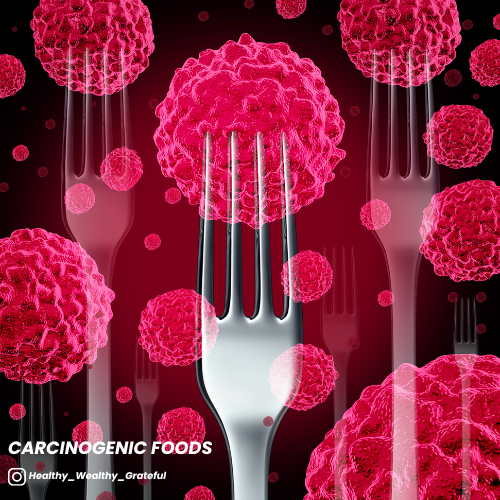In our journey towards optimal well-being, one of the essential factors often overlooked is the impact of our dietary choices on our health. As a wellness coach committed to natural remedies and sustainable lifestyle changes, I understand the importance of nourishing our bodies with whole foods. A crucial aspect of this is being informed about carcinogens, substances that have the potential to cause cancer. This article aims to provide insights into what it means for a substance to be “carcinogenic,” the varying levels of carcinogenicity in foods, and the surprising presence of some of the most perilous foods within the Western diet.

Understanding Carcinogens
Carcinogens are substances that can lead to the development of cancer in living organisms.
They may cause DNA mutations or interfere with cellular processes, promoting the growth of abnormal cells that can eventually lead to cancer.
Carcinogens can be present in various forms, including chemicals, pollutants, and even certain foods.
Levels of Carcinogenic Foods
The International Agency for Research on Cancer (IARC), a specialized agency of the World Health Organization, classifies substances based on their potential to cause cancer. These classifications include:
- Group 1: Carcinogenic to Humans
- Substances in this group are proven to cause cancer in humans. They pose the highest risk and should be minimized or avoided whenever possible. Examples include tobacco smoke, asbestos, and arsenic.
- In 2015 the World Health Organization classified processed meats like ham, bacon, sausage, hot dogs, and lunch meat as a Group 1 Carcinogen.
- Group 2A: Probably Carcinogenic to Humans
- Substances in this group are likely to cause cancer but may not yet have enough conclusive evidence for a definite classification. These require careful consideration and moderation. Think red meat and other unprocessed meats like veal, pork and lamb.
- Group 2B: Possibly Carcinogenic to Humans
- This category includes substances that have shown limited evidence of causing cancer in animals or cells but lack sufficient human data. Interpret these findings with caution. Examples include coffee and certain pesticides.
- Group 3: Not Classifiable as to Carcinogenicity
- Substances in this group have inadequate evidence to determine their carcinogenicity. More research is needed to make a conclusive judgment. Examples include glyphosate (a common herbicide) and high-temperature frying.
- Group 4: Probably Not Carcinogenic to Humans
- Substances in this category are unlikely to cause cancer. They are considered safe for consumption in terms of carcinogenicity. Examples include non-alcoholic beverages and certain food additives.
Source: IARC Monographs on the Evaluation of Carcinogenic Risks to Humans.

Carcinogens in the Western Diet
It’s unsettling to realize that some of the most popular foods in the Western diet fall into the higher risk categories. Processed meats, including sausages, bacon, and hot dogs, are classified as Group 1 carcinogens, posing a clear danger to human health. These foods are often staples in diets, emphasizing the need for a shift towards whole foods like fruits, vegetables, beans, and legumes.
By understanding the levels of carcinogenicity in foods and recognizing the presence of dangerous foods in the Western diet, you empower yourself to make informed choices that support long-term physical and mental well-being. Remember, just a few small, sustainable changes in your dietary habits can lead to significant, and lasting improvements overtime.
As you know, natural, realistic, lifestyle changes that help us stretch toward our goals and craft the best versions of ourselves is exactly what we’re all about. So, naturally, we’ll drop a few tools and resources below to help guide you in this pursuit.

